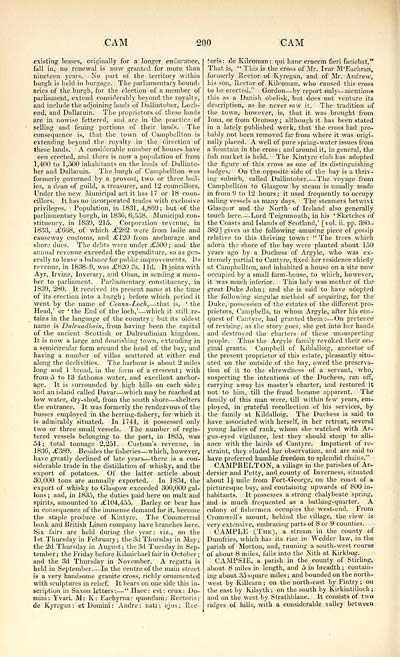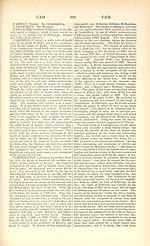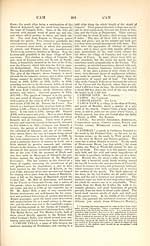Topographical, statistical, and historical gazetteer of Scotland > Volume 1
(280) Page 200
Download files
Complete book:
Individual page:
Thumbnail gallery: Grid view | List view

CAM
200
CAM
existing leases, originally for a longer endurance,
fall in, no renewal is now granted for more than
nineteen years. No part of the territory within
burgh is held in burgage. The parliamentary bound-
aries of the burgh, for the election of a member of
parliament, extend considerably beyond the royalty,
and include the adjoining lands of Dallintober, Loch-
end, and Dallaruin. The proprietors of these lands
are in nowise fettered, and are in the practice of
selling and feuing portions of their lands. The
consequence is, that the town of Campbellton is
extending beyond the royalty in the direction of
these lands. A considerable number of houses have
een erected, and there is now a population of from
1,400 to 1,500 inhabitants on the lands of Dallinto-
ber and Dallaruin. The burgh of Campbellton was
formerly governed by a provost, two or three bail-
ies, a dean of guild, a treasurer, and 12 councillors.
Under the new Municipal act it has 17 or 18 coun-
cillors. It has no incorporated trades with exclusive
privileges. Population, in 1831, 4,869; but of the
parliamentary burgh, in 1836, 6,558. Municipal con-
stituency, in 1839, 215. Corporation revenue, in
1833, £068, of which £282 were from ladle and
causeway customs, and £120 from anchorage and
shore dues. The debts were under £500 ; and the
annual revenue exceeded the expenditure, so as gen-
erally to leave a balance for public improvements. Its
revenue, in 1838-9, was £820 3s. lid. It joins with
Ayr, Irvine, Inverary, and Oban, in sending a mem-
ber to parliament. Parliamentary constituency, in
1839, 280. It received its present name at the time
of its erection into a burgh ; before which period it
went by the name of Ceann-Loch, — that is, ' the
Head,' or ' the End of the loch,' — which it still re-
tains in the language of the country : but its oldest
name is Dahuadhoin, from having been the capital
of the ancient Scottish or Dalreudinian kingdom.
It is now a large and flourishing town, extending in
a semicircular form around the head of the bay, and
having a number of villas scattered at either end
along the declivities. The harbour is about 2 miles
long and 1 broad, in the form of a crescent ; with
from 5 to 13 fathoms water, and excellent anchor-
age. It is surrounded by high hills on each side ;
and an island called Davar — which may be reached at
low water, dry-shod, from the south shore — shelters
the entrance. It was formerly the rendezvous of the
busses employed in the herring-fishery, for which it
is admirably situated. In 1744, it possessed only
two or three small vessels. The number of regis-
tered vessels belonging to the port, in 1835, was
54; total tonnage 2,251. Custom's revenue, in
1 836, £389. Besides the fisheries — which, however,
have greatly decb'ned of late years — there is a con-
siderable trade in the distillation of whisky, and the
export of potatoes. Of the latter article about
30,000 tons are annually exported. In 1834, the
export of whisky to Glasgow exceeded 300,000 gal-
lons ; and, in 1835, the duties paid here on malt and
spirits, amounted to £104,455. Barley or bear has
in consequence of the immense demand for it, become
the staple produce of Kintyre. The Commercial
bank and British Linen company have branches here.
Six fairs are held during the year; viz., on the
1st Thursday in February; the 3d Thursday in May;
the 2d Thursday in August; the 3d Tuesday in Sep-
tember ; the Friday before Kilinichael fair in October ;
and the 3d Thursday in November. A regatta is
held in September In the centre of the main street
is a very handsome granite cross, richly ornamented
with sculptures in rehef. It bears on one side this in-
scription in Saxon letters: — " Haec: est; crux: Do-
mini: Yvari. M: K: Eachyma: quondam: Rectoris:
de Kyregan: et Domini : Andre: nati : ejus: Rec-
toris: de Kilcoman: qui banc crucem fieri faciebat."
That is, " This is the cross of Mr. Ivar M'Eachran,
formerly Rector of Kyregan, and of Mr. Andrew,
his son, Rector of Kilcoman, who caused this cross
to be erected." Gordon — by report only — mentions
this as a Danish obelisk, but does not venture its
description, as he never saw it. The tradition of
the town, however, is, that it was brought from
Iona, or from Oronsay ; although it has been stated
in a lately published work, that the cross had pro-
bably not been removed far from where it was origi-
nally placed. A well of pure spring- water issues from
a fountain in the cross ; and around it, in general, the
fish market is held. The Kintyre club has adopted
the figure of this cross as one of its distinguishing
badges. On the opposite side of the bay is a thriv-
ing suburb, called Dallintober The voyage from
Campbellton to Glasgow by steam is usually made
in from 9 to 1 2 hours ; it used frequently to occupy
sailing vessels as many days. The steamers betwixt
Glasgow and the North of Ireland also generally
touch here. — Lord Teignmouth, in his ' Sketches of
the Coasts and Islands of Scotland,' [vol. ii. pp. 380-
382] gives us the following amusing piece of gossip
relative to this thriving town: "The trees which
adorn the shore of the bay were planted about 150
years ago by a Duchess of Argyle, who was ex-
tremely partial to Cantyre, fixed her residence chiefly
at Campbellton, and inhabited a house on a site now
occupied by a small farm-house, to which, however,
it was much inferior. This lady was mother of the
great Duke John ; and she is said to have adopted
the following singular method of acquiring, for the
Duke, possession of the estates of the different pro-
prietors, Campbells, to whom Argyle, after his con-
quest of Cantyre, had granted them : — On pretence
of revising, as the story goes, she got into her hands
and destroyed the charters of these unsuspecting
people. Thus the Argyle family revoked their ori-
ginal grants. Campbell of Kildalloig, ancestor of
the present proprietor of this estate, pleasantly situ-
ated on the outside of the bay, owed the preserva-
tion of it to the shrewdness of a servant, who,
suspecting the intentions of the Duchess, ran off,
carrying away his master's charter, and restored it
not to him, till the fraud became apparent. The
family of this man were, till within few years, em-
ployed, in grateful recollection of his services, by
the family at Kildalloig. The Duchess is said to
have associated with herself, in her retreat, several
young ladies of rank, whom she watched with Ar-
gus-eyed vigilance, lest they should stoop to alli-
ance with the lairds of Cantyre. Impatient of re-
straint, they eluded her observation, and are said to
have preferred humble freedom to splendid chains."
CAMPBELTON, a village in the parishes of Ar-
dersier and Petty, and county of Inverness, situated
about li mile from Fort-George, on the coast of a
picturesque bay, and containing upwards of 800 in-
habitants. It possesses a strong chalybeate spring,
and is much frequented as a bathing-quarter. A
colony of fishermen occupies the west-end. From
Cromwell's mount, behind the village, the view is
very extensive, embracing parts of 8 or 9 counties.
CAMPLE (The), a stream in the county of
Dumfries, which has its rise in Wedder law, in the
parish of Morton, and, running a south-west course
of about 8 miles, falls into the Nith at Kirkbog.
CAMPSIE, a parish in the county of Stirling,
about 8 miles in length, and 5 in breadth ; contain-
ing about 35 square miles ; and bounded on the north-
west by Killearn ; on the north-east by Fintry ; on
the east by Kilsyth; on the south by Kirkintilloch ;
and on the west "by Strathblane. It consists of two
ridges of hills, with a considerable valley between
200
CAM
existing leases, originally for a longer endurance,
fall in, no renewal is now granted for more than
nineteen years. No part of the territory within
burgh is held in burgage. The parliamentary bound-
aries of the burgh, for the election of a member of
parliament, extend considerably beyond the royalty,
and include the adjoining lands of Dallintober, Loch-
end, and Dallaruin. The proprietors of these lands
are in nowise fettered, and are in the practice of
selling and feuing portions of their lands. The
consequence is, that the town of Campbellton is
extending beyond the royalty in the direction of
these lands. A considerable number of houses have
een erected, and there is now a population of from
1,400 to 1,500 inhabitants on the lands of Dallinto-
ber and Dallaruin. The burgh of Campbellton was
formerly governed by a provost, two or three bail-
ies, a dean of guild, a treasurer, and 12 councillors.
Under the new Municipal act it has 17 or 18 coun-
cillors. It has no incorporated trades with exclusive
privileges. Population, in 1831, 4,869; but of the
parliamentary burgh, in 1836, 6,558. Municipal con-
stituency, in 1839, 215. Corporation revenue, in
1833, £068, of which £282 were from ladle and
causeway customs, and £120 from anchorage and
shore dues. The debts were under £500 ; and the
annual revenue exceeded the expenditure, so as gen-
erally to leave a balance for public improvements. Its
revenue, in 1838-9, was £820 3s. lid. It joins with
Ayr, Irvine, Inverary, and Oban, in sending a mem-
ber to parliament. Parliamentary constituency, in
1839, 280. It received its present name at the time
of its erection into a burgh ; before which period it
went by the name of Ceann-Loch, — that is, ' the
Head,' or ' the End of the loch,' — which it still re-
tains in the language of the country : but its oldest
name is Dahuadhoin, from having been the capital
of the ancient Scottish or Dalreudinian kingdom.
It is now a large and flourishing town, extending in
a semicircular form around the head of the bay, and
having a number of villas scattered at either end
along the declivities. The harbour is about 2 miles
long and 1 broad, in the form of a crescent ; with
from 5 to 13 fathoms water, and excellent anchor-
age. It is surrounded by high hills on each side ;
and an island called Davar — which may be reached at
low water, dry-shod, from the south shore — shelters
the entrance. It was formerly the rendezvous of the
busses employed in the herring-fishery, for which it
is admirably situated. In 1744, it possessed only
two or three small vessels. The number of regis-
tered vessels belonging to the port, in 1835, was
54; total tonnage 2,251. Custom's revenue, in
1 836, £389. Besides the fisheries — which, however,
have greatly decb'ned of late years — there is a con-
siderable trade in the distillation of whisky, and the
export of potatoes. Of the latter article about
30,000 tons are annually exported. In 1834, the
export of whisky to Glasgow exceeded 300,000 gal-
lons ; and, in 1835, the duties paid here on malt and
spirits, amounted to £104,455. Barley or bear has
in consequence of the immense demand for it, become
the staple produce of Kintyre. The Commercial
bank and British Linen company have branches here.
Six fairs are held during the year; viz., on the
1st Thursday in February; the 3d Thursday in May;
the 2d Thursday in August; the 3d Tuesday in Sep-
tember ; the Friday before Kilinichael fair in October ;
and the 3d Thursday in November. A regatta is
held in September In the centre of the main street
is a very handsome granite cross, richly ornamented
with sculptures in rehef. It bears on one side this in-
scription in Saxon letters: — " Haec: est; crux: Do-
mini: Yvari. M: K: Eachyma: quondam: Rectoris:
de Kyregan: et Domini : Andre: nati : ejus: Rec-
toris: de Kilcoman: qui banc crucem fieri faciebat."
That is, " This is the cross of Mr. Ivar M'Eachran,
formerly Rector of Kyregan, and of Mr. Andrew,
his son, Rector of Kilcoman, who caused this cross
to be erected." Gordon — by report only — mentions
this as a Danish obelisk, but does not venture its
description, as he never saw it. The tradition of
the town, however, is, that it was brought from
Iona, or from Oronsay ; although it has been stated
in a lately published work, that the cross had pro-
bably not been removed far from where it was origi-
nally placed. A well of pure spring- water issues from
a fountain in the cross ; and around it, in general, the
fish market is held. The Kintyre club has adopted
the figure of this cross as one of its distinguishing
badges. On the opposite side of the bay is a thriv-
ing suburb, called Dallintober The voyage from
Campbellton to Glasgow by steam is usually made
in from 9 to 1 2 hours ; it used frequently to occupy
sailing vessels as many days. The steamers betwixt
Glasgow and the North of Ireland also generally
touch here. — Lord Teignmouth, in his ' Sketches of
the Coasts and Islands of Scotland,' [vol. ii. pp. 380-
382] gives us the following amusing piece of gossip
relative to this thriving town: "The trees which
adorn the shore of the bay were planted about 150
years ago by a Duchess of Argyle, who was ex-
tremely partial to Cantyre, fixed her residence chiefly
at Campbellton, and inhabited a house on a site now
occupied by a small farm-house, to which, however,
it was much inferior. This lady was mother of the
great Duke John ; and she is said to have adopted
the following singular method of acquiring, for the
Duke, possession of the estates of the different pro-
prietors, Campbells, to whom Argyle, after his con-
quest of Cantyre, had granted them : — On pretence
of revising, as the story goes, she got into her hands
and destroyed the charters of these unsuspecting
people. Thus the Argyle family revoked their ori-
ginal grants. Campbell of Kildalloig, ancestor of
the present proprietor of this estate, pleasantly situ-
ated on the outside of the bay, owed the preserva-
tion of it to the shrewdness of a servant, who,
suspecting the intentions of the Duchess, ran off,
carrying away his master's charter, and restored it
not to him, till the fraud became apparent. The
family of this man were, till within few years, em-
ployed, in grateful recollection of his services, by
the family at Kildalloig. The Duchess is said to
have associated with herself, in her retreat, several
young ladies of rank, whom she watched with Ar-
gus-eyed vigilance, lest they should stoop to alli-
ance with the lairds of Cantyre. Impatient of re-
straint, they eluded her observation, and are said to
have preferred humble freedom to splendid chains."
CAMPBELTON, a village in the parishes of Ar-
dersier and Petty, and county of Inverness, situated
about li mile from Fort-George, on the coast of a
picturesque bay, and containing upwards of 800 in-
habitants. It possesses a strong chalybeate spring,
and is much frequented as a bathing-quarter. A
colony of fishermen occupies the west-end. From
Cromwell's mount, behind the village, the view is
very extensive, embracing parts of 8 or 9 counties.
CAMPLE (The), a stream in the county of
Dumfries, which has its rise in Wedder law, in the
parish of Morton, and, running a south-west course
of about 8 miles, falls into the Nith at Kirkbog.
CAMPSIE, a parish in the county of Stirling,
about 8 miles in length, and 5 in breadth ; contain-
ing about 35 square miles ; and bounded on the north-
west by Killearn ; on the north-east by Fintry ; on
the east by Kilsyth; on the south by Kirkintilloch ;
and on the west "by Strathblane. It consists of two
ridges of hills, with a considerable valley between
Set display mode to: Large image | Transcription
Images and transcriptions on this page, including medium image downloads, may be used under the Creative Commons Attribution 4.0 International Licence unless otherwise stated. ![]()
| Gazetteers of Scotland, 1803-1901 > Topographical, statistical, and historical gazetteer of Scotland > Volume 1 > (280) Page 200 |
|---|
| Permanent URL | https://digital.nls.uk/97440906 |
|---|
| Description | Volume first. A-H. |
|---|---|
| Attribution and copyright: |
|

